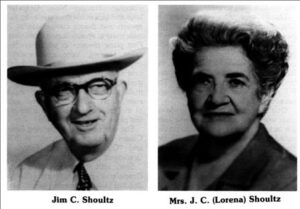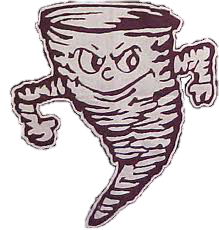J.C. Shoultz

J.C. Shoultz Family History

J.C. Shoultz’s ancestors came from Germany, settling in Pennsylvania. His grandfather moved to Randolph, Alabama, where his father, Geroge W. Shoultz, was born. His mother and father came to Texas with two children soon after the Civil War and bought a farm near Longview, where Jim was born. He was the youngest of nine children. Lorena Wright Shoultz is of mixed descent. One of her grandfathers was English and the other French. Her great-grandfather, W.A. Wright, purchased land bordering on the Sabine River in Rusk and Gregg Counties. He came from Mississippi bringing an unknown number of Negro slaves with him. Lorena’s mother died when she was nine months old and her grandparents reared her. They were old. He was a Confederate soldier. Jim Shoultz was a graduate of North Texas Teacher’s College at Denton and had spent a year at the University of Texas working on a B.S. degree. He later finished it at Texas A&M along with a Master’s Degree. Lorena studied three years at Texas Christian Universitymajoring in English and a double minor in speech and history. She later studied at Texas University, Sam Houston State University, where she received a B.S. degree, and later studied and received a diploma from the “A.A. Cocke’s School of Speech” in Dallas. They grew up on opposite sides of the Sabine River with the town of Longview, in Gregg County, as their hub of activities. They were married at her grandfather’s home in 1916. They were both teachers but there were six sojourns, stop overs or halts before they came to live in Grapeland or Houston County. Jim was superintendent of schools at each place they lived except the last, Crockett, where he was a County Farm Extension Agent. While at A&M, Jim had been thrown with the Extension Service in the Ag Department and he admired them. They invited him to join the service and named three counties, any one of which he might serve as County Agent. Houston County was one of the three and he chose it. He and his family have always been pleased with his choice. Crockett was a whole new baligame. Jim’s work had been with young people. Now it was practically all with grown-up, mature men and women. He wanted to make good! He pulled on his previous training and collected all the information he could find on Extension Service at A&M University and hit it hard. The people at Crockett were interested and helpful. Charley Towery was president of the Crockett Chamber of Commerce and Moze Bromburg secretary. They backed him in every way possible. They purchased a movie projector and trailer and he often carried a movie which demonstrated a good or new farm practice to the farmers. There was terracing, doctoring animals, spraying – so many things they did all over the county. There were W.E. Elkins and W.H. Collins, at Lovelady, George Jeffus at Austonio with a large nursery and hundreds of bee hives where he sold and shipped honey all over the state. The people in North Houston County, Grapeland, were especially wide awake, anxious to improve. They were ready to do anything for the betterment of the community. Chamber of Commerce President M.E. Darsey, working with Jim, bought and distributed two car loads of registered Jersey gilts. This was followed by getting eighteen registered Jersey bulls and the formation of a bull circle for the stock farmers. “Diversification” was the key word! “Don’t put all your eggs in one basket.” A long range agricultural plan began to be discussed for Grapeland and North Houston County. At that time a new “item” was on the market – the pit toilet-to-be installed in homes where there was no electricity or running water. A large number of the toilets were installed in Houston County. A young couple had just built a new home in Grapeland and bought one of the toilets. Her father smoked a pipe, seldom taking it from his mouth. He visited them and naturally visited the toilet. The lady heard a loud explosion one day when he was out and rushed to the door. She saw her father leaving the toilet, his pants in disarray. She called: “Oh, Papa, what is it?” He replied, “I don’t know, I must have ‘et somethin’.” Sparks from his pipe had ignited the chemicals in the pit below. Asadness came to the Shoultz family while they were in Crockett. Their second son, Vardeman, had polio poliomyelitis. He was seven years old. It was very hard. They carried him to Houston for treatment with a specialist and later, to Warm Springs, Georgia, for a conference with Pres. Roosevelt’s doctor. There he was told to put braces on his leg and make the most of his good brain. They tried to do that. One afternoon Jim received a call to come to an important meeting at Grapeland that night, and he went not knowing what it was about. When he returned home, late, he said, “We’re moving to Grapeland!!!” The J.C. Shoultz family came to Grapeland in 1929. It consisted of Jim and Lorena Shoultz and their three children, James, Vardeman and Jack Shoultz. Jim Shoultz came to Grapeland as teacher of Vocational Agriculture in the high school. He held this for twenty five years. In connection with Ag teacher he was secretary of the North Houston County Chamber of Commerce at Grapeland and later president of that organization. He taught the Men’s Bible Class at the First Methodist Church for twenty years. Grapeland was and is a farming community. The chief farm crops through the years were cotton, corn and peas. The streets in Grapeland were covered with wagons of cotton on Saturdays. It is said that Charlie Kennedy could make his way home by stepping from one cotton wagon to the next at the lunch hour. As agriculture teacher and secretary of Commerce, Jim, with the aid of progressive farmers and businessmen, was able to institute a program of diversification which succeeded in many ways and brought progress with it. There were Murdoch Darsey, whom Jim believed to be a great civic minded man, George E. Darsey, Will Darsey, Jim Ryan, Otto Walling (Jim called him Coz. Otto), Charlie and Chester Kennedy, John A. Brimberry, Leon Anderson, W.A. Riall, Kelly Chapman, Johnny Wilkins, Henry Dailey, and “Kid” Luker, editor of the Grapeland Messenger. One could never name them all. New live stock had been brought in for the farmers and a bull circle established. Growing tomatoes and watermelons was encouraged, and the growers became organized. Other crops were put into production, such as peaches, plums, berries, cucumbers. The Bruce plum was a great crop and a boost for farmers. As remembered, Jim would, many, many times spend an entire Saturday going from one farm produce meeting to another. The second year seventy carloads of tomatoes were shipped out. One year more farm produce was shipped from Grapeland than from any other town in Texas with the exception of San Antonio. There were few trucks operating at that time. The farmers grew chickens and many eggs were brought into town for shipment. Jack Shoultz worked at Darsey’s store on Saturdays, checking in the eggs and placing them in crates for shipment. One Saturday he wrote his name and address on a crate. (He was eleven years old at the time.) The next week he received a letter from a twenty-four year old lady atDallas asking him to come to Dallas to see her. She described herself and told him she was anxious to meet him. Jack gave the letter to a bov in town and left off putting his name on crates. The Chamber of Commerce was ever on the alert for any progressive act. Some of the members drove late into the night one time getting a petition signed to get a hard surface road from Grapeland to Percilla. It, the petition, had to be in Austin the next day. They got it signed and carried it to Austin. Jim Shoultz drove. When they started home that night, Jim asked for someone else to drive since he was sleepy. Charley Haltom agreed to drive and the others got in the car and tried to sleep. They were awakened by a great sliding and bumping of the car. They sat up and said, “What in the world is the matter, Charlie?”. Haltom replied, “That darn fool wants all the road.” They looked and saw a train bearing down on them. They were on the railroad track! Shoultz drove home. During these years, a cheese plant was brought in and did well for some time, but a drought came, feed became a problem and production fell off. A canning factory and turkey hatchery were also brought in. The agriculture class operated a small hatchery at the school. Many of their projects were chickens. One of the first things Shoultz and the agriculture students did was rid the city ceme tery of the red ants, which were taking it over. They also dug a water line to the football house so the boys could shower after practice each afternoon. They planted the pecans and many shrubs and trees on the high school campus. The tall shade trees which one sees there today were planted by Ag boys and a teacher some fifty years ago. The class often took trips in the summer. One year they loaded a big school bus and went to the World’s Fair at San Francisco. They won many honors with their work. The National Association of Future Farmers sent representatives to all the states to check the quality of the work being done. One man was sent to each state to check only two chapters to the state. Grapeland’s chapter was one of those chapters. Buddy Anderson was president of the chapter. Mr. Shoultz turned the inquisition over to Buddy. He handled it. When someone asked Shoultz how Buddy came out he replied, “What a Prince! He was great! We made a high score!” There were no veterinarians in Grapeland and Jim tried to take their place. He was on the phone often to Texas A&M asking for advice. He had a good veterinarian friend whom he called often In Palestine for information. He learned fast and tried to treat any livestock trouble that came up. The F.F.A. boys went along with him and became good at it, too. One of the boys had a low grade on class work and asked to do some extra job to try to bring his work up. So Jim called him one day to go out with him and help a cow that was trying to have a calf. The boy said “Fine!” and went with him. Jim stood by him telling him exactly what to do. Right in the middle of the job the young man fainted. He brought his grade up. Not all his endeavors were successful but he and the others who worked with him kept trying. Jim always credited his success to the fact that he fell heir to a live and growing community and to a great group of people. As to his work as agriculture teacher, the following is a paragraph taken from the “Handbook and History of the Vocational Teachers Association of Texas”: During the twenty-five years he taught at Grapeland, Jim Shoultz became a legend among the teachers of vocational agriculture in the Piney Woods section of Texas. No other teacher has ever commanded more respect and admiratio from his colleagues than Jimmy Shoultz. He was considered the ‘Dean of Teachers of Vocational Agriculture’ in his region. Many of his former students followed in his footsteps to become teachers of Vocational Agriculture and he took special delight in the fact that five or six of his students became ministers. Mr. Shoultz’s primary objectives were to develop men first and to teach vocational agriculture second.’ The Grapeland High School Annual was dedicated to him in 1956 with the inscription: ‘To the man who gave so much and asked so little.’ The Grapeland High School Library is called the “J.C. Shoultz Memorial Library.” Mrs. Shoultz began teaching in Grapeland High School in 1944 and retired in 1972. She taught English, Social Science and Speech. She was the Senior Class sponsor for eighteen years and organized and sponsored the Thespian Troupe. Many Grapeland boys and girls made their way to finals in speech and drama competition at the state meet atAustin during those years. First place plaques in poetry reading, prose reading, informative speaking and one-act plays are seen in the trophy case at the high school. She was always glad that her students had been able to make their way to the finals in Austin many times, doing cuttings from some of the great classic plays and winning first place with some of them. She was named “Outstanding Senior Citizen of Houston County” in 1967 and “Outstanding Senior Citizen of Grapeland” in 1974. She, with the cooperation of the Grapeland people, arranged and directed two minstrels which were presented each summer for two years to raise money to build a hospital. She directed the Centennial Pageant “Let’s Call It Grapeland”, when the town celebrated its hundredth year. The high school auditorium bears her name. After retiring from teaching, Lorena was president of the Grapeland Garden Club for four years, District Director of District III for two years, State Chaplain of Texas Garden Clubs for two years. She has coached the Grapeland Garden Club’s Youth Communication Speakers for nine years. They have won first place in the state for seven years and first place in the nation one year and second place in the nation one year. She has considered herself very fortunate to have been able to work with high school students on many programs. The Grapeland Garden Club honored her at the Southern Zone Fall Meeting at Grapeland on Nov. 6, 1985. The Grapeland Garden Club Year Book for 1985 was dedicated to her and in July 1986 the club arranged to have her name placed on a bronze plaque to be hung in the main hall of the State Garden ClubBuilding in Fort Worth. Each of the Shoultz boys finished school at Grapeland. They thought it was a great high school. “Remember Miss Thois Elliott and her Public School Music?” The Shoultz boys made professional men. The eldest, James, graduated from TexasA&M University. He spent thirty years in the army and retired as colonel in 1971. His last appointments before retiring were as second-incommand of the U.S. Military Police Forces of Europe, U.S. Deputy Provost Marshall General for three years atWashington and two years as commander of U.S. Army Correctional Training Facility at Fort Riley, Kansas. He married Alice Hucke Shoultz and they have two children. James became Supt. of Correction for Orlando County in Orlando, Florida soon after he retired from the army. He has continued with that kind of work. His training in the army opened many doors for him. Dr. Vardeman Shoultz graduated from Texas Christian University and Texas Medical College at Galveston. He married Jean Abbot Shoultz. They have four children and live in Abilene where he is a radiologist. Dr. Shoultz is past president of the Texas Radiology Society, a Texas Diplomat of the American Board of Radiology and Fellow of the American College of Radiology. He served as President of the Board of Hendrick’s Hospital for some ten or twelve years and is at present, a member of the board. He has guided the hospital in its purchases of all its radiological equipment. Vardeman began his work at Abilene in an office alone. There are eleven to fourteen doctors in the office today and they serve hospitals in a large part of West Texas. Year before last, the Abilene doctors presented him with the Gold Cain award for his service to the doctors and to humanity. The youngest son, Jack, graduated from Stephen F.Austin University and Perkins School of Theology at Southern Methodist University. He and his wife, Gene Dailey Shoultz, and two daughters lived in Beaumont where he was District Superintendent of the Beaumont District of the United Methodist Church. Prior to becoming District Superintendent of the Beaumont District, he was pastor at Alvin United Methodist Church. He served several Houston churches, the last being Westberry First Methodist. At the present time he is a pastor of the First Methodist Church at Lufkin and at this writing he and Gene are in Kenya, Africa, where he is a delegate to the International Conference for World Methodist. The Shoultz family is proud of all the years It has been privileged to spend in Grapeland.

